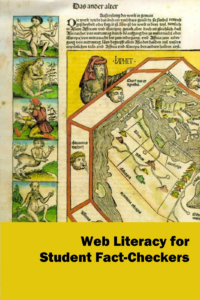If you are thinking of creative ways to prepare for your library instruction during the school year, consider checking out Web Literacy for Student Fact-Checkers by Mike Caulfield (2018). Caulfield is currently the director of blended and networked learning at Washington State University Vancouver and head of the Digital Polarization Initiative of the American Democracy Project.
In this open-access publication, Caulfield provides many useful strategies, exercises, and activities on how to teach “web literacy” critically to students. Caulfield writes that this is a “practical guide for the student fact-checker” (p. 3). Today’s college students are facing an incredible wealth of information from the news and from their research. From fact-checking Wikipedia to finding original sources of a viral post on social media to identifying owners/creators of websites, this free guide can be a starting point to teach research techniques that can help students understand veracity and the importance of fact-checking, and how to be “web-literate.”
Here are some suggestions for using this instructional manual:
Course-Integrated Workshops


Icebreakers
These activities can serve as icebreakers that encourage students to think about online information and evaluate the content critically. You can cover web research strategies for students to learn different techniques comparing library vs. web research openly. Similar to the CRAAP Test, Caulfield provides a list of websites and asks students to “answer the following questions to determine the reputability of each site: Who runs them? To what purpose? What is their history of accuracy, and how do they rate on process, aim, and expertise?” (p. 91). This activity can be helpful to show students how to identify and evaluate bias in online information. You can have students compare the content they find in these websites with other similar content found online or in library databases to see how credible or incredible online information can be.
Group Activities
These exercises can be also integrated into a larger competitive group activity where students can work in teams to learn about different veracity techniques and apply them to the research game. By gamifying the process, students may be more motivated to engage and learn from their experiences and teamwork. You can have students break into groups and solve the exercises themselves (fake image vs. real image), cite a viral social media post in APA/MLA/Chicago citation, and/or use the fact-checking process on specific quotes and events. After giving time for students to complete these short exercises, you can reveal the correct answers and show them how to verify images, texts, and content that they often encounter online.
There are many other examples that Caulfield provides throughout the book. These exercises are adapted into specific online modules. The key is to solicit feedback and reflections from students when they are doing these activities so that they can think through what they have learned and experienced. Another opportunity is to collaborate with a professor to co-teach these research skills to the general public in the academic library or in a public library. Web Literacy for Student Fact-Checkers is definitely worth exploring, particularly for those librarians who often teach information literacy workshops to first-year writing, communication/media studies, and journalism.
See also:
- How to Evaluate Any News Content for Reliability and Bias
- How to Incorporate News Literacy into Any Curriculum and Be Confident in Evaluating News Content from Any Source
- Why It Is Challenging to Teach News Literacy in Today’s World, and How to Do So Effectively Anyway
- You Say Fake News, I Say Misinformation: What’s in a Term
- News Literacy 4-Part Workshop


